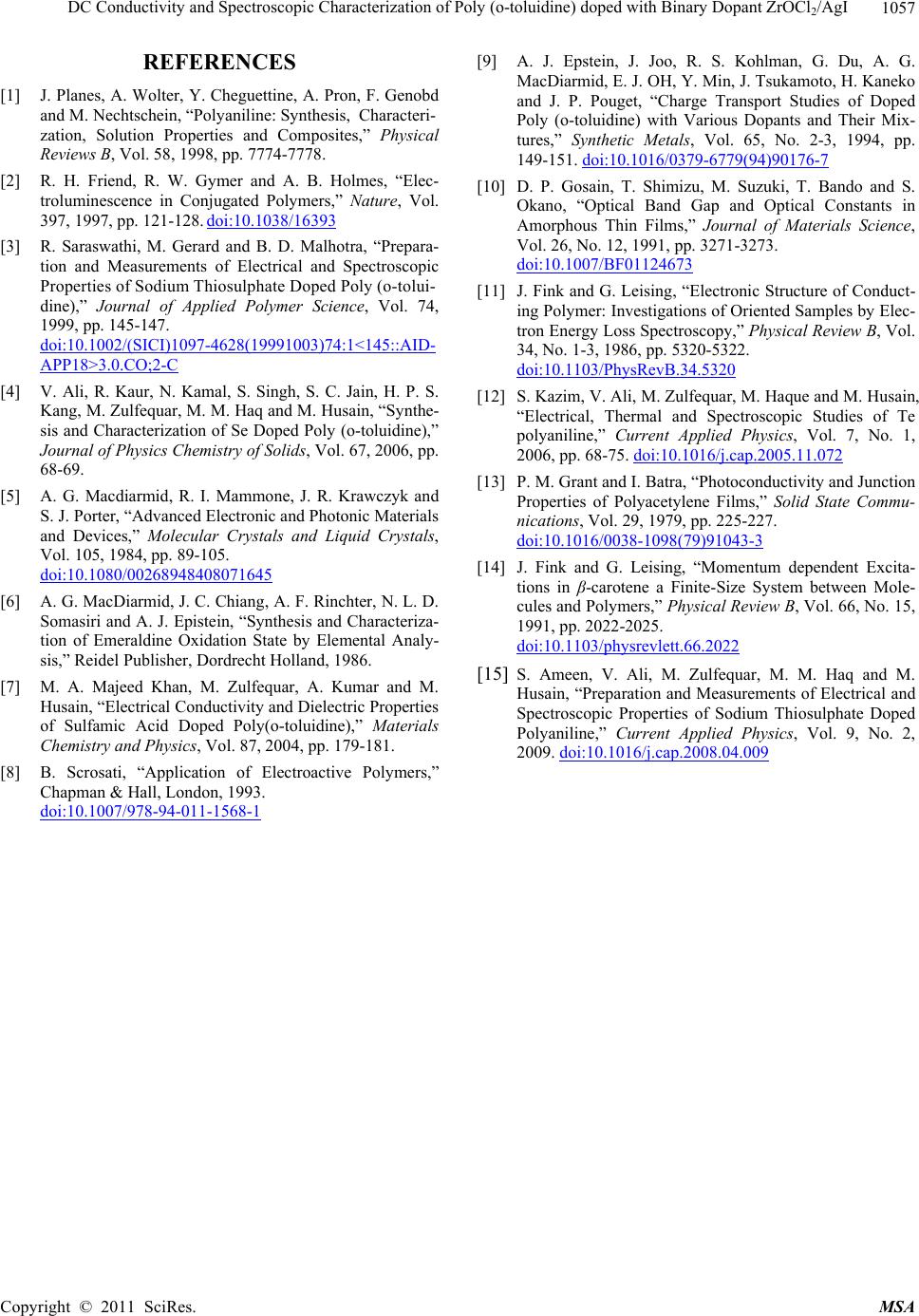
DC Conductivity and Spectroscopic Characterization of Poly (o-toluidine) doped with Binary Dopant ZrOCl/AgI 1057
2
REFERENCES
[1] J. Planes, A. Wolter, Y. Cheguettine, A. Pron, F. Genobd
and M. Nechtschein, “Polyaniline: Synthesis, Characteri-
zation, Solution Properties and Composites,” Physical
Reviews B, Vol. 58, 1998, pp. 7774-7778.
[2] R. H. Friend, R. W. Gymer and A. B. Holmes, “Elec-
troluminescence in Conjugated Polymers,” Nature, Vol.
397, 1997, pp. 121-128. doi:10.1038/16393
[3] R. Saraswathi, M. Gerard and B. D. Malhotra, “Prepara-
tion and Measurements of Electrical and Spectroscopic
Properties of Sodium Thiosulphate Doped Poly (o-tolui-
dine),” Journal of Applied Polymer Science, Vol. 74,
1999, pp. 145-147.
doi:10.1002/(SICI)1097-4628(19991003)74:1<145::AID-
APP18>3.0.CO;2-C
[4] V. Ali, R. Kaur, N. Kamal, S. Singh, S. C. Jain, H. P. S.
Kang, M. Zulfequar, M. M. Haq and M. Husain, “Synthe-
sis and Characterization of Se Doped Poly (o-toluidine),”
Journal of Physics Chemistry of Solids, Vol. 67, 2006, pp.
68-69.
[5] A. G. Macdiarmid, R. I. Mammone, J. R. Krawczyk and
S. J. Porter, “Advanced Electronic and Photonic Materials
and Devices,” Molecular Crystals and Liquid Crystals,
Vol. 105, 1984, pp. 89-105.
doi:10.1080/00268948408071645
[6] A. G. MacDiarmid, J. C. Chiang, A. F. Rinchter, N. L. D.
Somasiri and A. J. Epistein, “Synthesis and Characteriza-
tion of Emeraldine Oxidation State by Elemental Analy-
sis,” Reidel Publisher, Dordrecht Holland, 1986.
[7] M. A. Majeed Khan, M. Zulfequar, A. Kumar and M.
Husain, “Electrical Conductivity and Dielectric Properties
of Sulfamic Acid Doped Poly(o-toluidine),” Materials
Chemistry and Physics, Vol. 87, 2004, pp. 179-181.
[8] B. Scrosati, “Application of Electroactive Polymers,”
Chapman & Hall, London, 1993.
doi:10.1007/978-94-011-1568-1
[9] A. J. Epstein, J. Joo, R. S. Kohlman, G. Du, A. G.
MacDiarmid, E. J. OH, Y. Min, J. Tsukamoto, H. Kaneko
and J. P. Pouget, “Charge Transport Studies of Doped
Poly (o-toluidine) with Various Dopants and Their Mix-
tures,” Synthetic Metals, Vol. 65, No. 2-3, 1994, pp.
149-151. doi:10.1016/0379-6779(94)90176-7
[10] D. P. Gosain, T. Shimizu, M. Suzuki, T. Bando and S.
Okano, “Optical Band Gap and Optical Constants in
Amorphous Thin Films,” Journal of Materials Science,
Vol. 26, No. 12, 1991, pp. 3271-3273.
doi:10.1007/BF01124673
[11] J. Fink and G. Leising, “Electronic Structure of Conduct-
ing Polymer: Investigations of Oriented Samples by Elec-
tron Energy Loss Spectroscopy,” Physical Review B, Vol.
34, No. 1-3, 1986, pp. 5320-5322.
doi:10.1103/PhysRevB.34.5320
[12] S. Kazim, V. Ali, M. Zulfequar, M. Haque and M. Husain,
“Electrical, Thermal and Spectroscopic Studies of Te
polyaniline,” Current Applied Physics, Vol. 7, No. 1,
2006, pp. 68-75. doi:10.1016/j.cap.2005.11.072
[13] P. M. Grant and I. Batra, “Photoconductivity and Junction
Properties of Polyacetylene Films,” Solid State Commu-
nications, Vol. 29, 1979, pp. 225-227.
doi:10.1016/0038-1098(79)91043-3
[14] J. Fink and G. Leising, “Momentum dependent Excita-
tions in β-carotene a Finite-Size System between Mole-
cules and Polymers,” Physical Review B, Vol. 66, No. 15,
1991, pp. 2022-2025.
doi:10.1103/physrevlett.66.2022
[15] S. Ameen, V. Ali, M. Zulfequar, M. M. Haq and M.
Husain, “Preparation and Measurements of Electrical and
Spectroscopic Properties of Sodium Thiosulphate Doped
Polyaniline,” Current Applied Physics, Vol. 9, No. 2,
2009. doi:10.1016/j.cap.2008.04.009
Copyright © 2011 SciRes. MSA